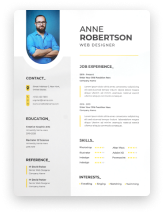Intro Lead Paragraphs:
Navigating the world of job applications can be daunting, especially when it comes to writing a cover letter that makes a lasting impression. A well-crafted cover letter is more than just a formal introduction to your resume; it's a personal statement that reflects your professionalism, enthusiasm, and fit for the role you're pursuing. In this comprehensive guide, we delve into the art and science of writing a compelling cover letter, providing you with actionable tips, step-by-step instructions, and real-life examples that will elevate your job application to the next level.
From understanding the essence of a cover letter to mastering its structure and content, our guide is tailored to equip you with the knowledge and confidence needed to create a standout cover letter. Whether you're a seasoned professional or a first-time job seeker, this article will guide you through the nuances of cover letter writing, ensuring that your application resonates with potential employers and sets you apart in the competitive job market. Prepare to embark on a journey to perfect your cover letter writing skills with our expert advice and practical examples.
What is a Cover Letter?
A cover letter is your personal introduction to a potential employer, showcasing not only your professional qualifications but also your personality and enthusiasm for the job. It's a one-page document, distinct from your resume, where you can tell your story in a way that data and bullet points on a resume simply can't. A great cover letter not only explains who you are and why you're sending your resume but also highlights your key achievements and skills, and most importantly, how they align with the job you're applying for.
Think of your cover letter as a pitch to the hiring manager. It's your chance to explain why you're the perfect fit for the role, how your unique experiences and skills make you an ideal candidate, and to demonstrate that you understand and align with the company's goals and values. It's about persuading the reader that you're worth an interview.
Remember, a cover letter is not just a rehash of your resume. It's an opportunity to go beyond the resume and provide context to your experiences, particularly those that directly relate to the job description.
Why is a Cover Letter Important?
-
First Impression: It's often the first piece of your application materials that a hiring manager sees, setting the tone for how they view you as a candidate.
-
Adds a Personal Touch: Unlike a resume, a cover letter lets you speak directly to the hiring manager, conveying your enthusiasm and personality.
-
Contextualizes Your Resume: It provides context for your experiences and skills, explaining how they make you a good fit for the job.
-
Demonstrates Writing Skills: It's a chance to show your ability to communicate effectively, a key skill in most jobs.
-
Addresses Specific Points: You can address specific parts of the job description, explain employment gaps, or discuss a career change in more detail.
Now that you understand what a cover letter is and its importance, let's dive into how to write one effectively.
How to Write a Cover Letter for a Resume in 10 Steps
STEP 1: Laying the Groundwork for an Impactful Cover Letter
Before you start writing, preparation is key. Begin by thoroughly reviewing the job requirements and understanding the needs of the company. Compare these requirements with your own skills and experiences. Here's what you should gather:
-
List of Your Accomplishments: Think about your achievements in previous roles. What are you most proud of? This could include sales targets met, processes improved, or successful project completions.
-
Relevant Skills: Identify the skills mentioned in the job posting and reflect on how your own skills align with these. This can include both hard skills (like proficiency in specific software) and soft skills (like leadership or communication).
-
Educational Qualifications: Note any degrees, certificates, or licenses you hold that are relevant to the job.
-
Research the Company: Understand their mission, values, and recent achievements. This knowledge will help you tailor your cover letter to show that you're not just a great candidate, but the right fit for their company culture.
STEP 2: Ensuring Your Contact Information Shines on Your Cover Letter
At the top of your cover letter, include your contact information:
-
Your Name
-
Address (City and State will suffice)
-
Phone Number
-
Email Address (Ensure it's professional)
-
LinkedIn Profile or professional portfolio (if applicable)
STEP 3: Effectively Addressing Your Cover Letter
Next, address the letter to the hiring manager or the department if the manager's name isn't available. Include:
-
The Date
-
Hiring Manager's Name and Title (if known)
-
Company Address
-
Hiring Manager's Email Address (if known)
Incorrect:
To Whom It May Concern,
Correct:
Dear Hiring Manager,
STEP 4: Personalizing Your Salutation: More Than Just "Dear Hiring Manager"
If possible, address the cover letter directly to the hiring manager by name. This personal touch can make a big difference. If you can't find the name, a generic "Dear Hiring Manager," is acceptable.
Incorrect:
Hi there!
Correct:
Dear [Hiring Manager's Full Name],
By preparing thoroughly and setting up the foundation of your cover letter correctly, you're on your way to making a strong first impression. Let's move on to crafting the content of your cover letter.
STEP 5: Crafting an Engaging Introduction: Make Your Cover Letter Stand Out
The introduction of your cover letter is your first opportunity to capture the hiring manager's attention. It sets the tone for the rest of your letter and can be the deciding factor in whether the rest of your application is considered. Here are some strategies to make your introduction stand out:
-
Showcase Your Enthusiasm and Confidence: Begin with a statement that reflects your excitement about the opportunity. Let your passion for the role and the company shine through right from the start.
-
Highlight Relevant Skills and Experiences: Briefly touch on the skills and experiences that make you an ideal candidate for the role. Tailor this to align closely with the job description.
-
Demonstrate Your Knowledge of the Company: Show that you have done your research. Mention something unique about the company, like a recent accomplishment or project, and tie it to your interest and suitability for the position.
-
Incorporate Creativity and Personalization: If you have a personal story or experience that connects to the company or the role, share it briefly. This can make your cover letter memorable.
-
Utilize Mutual Connections: If you were referred to the job by someone within the company or a mutual connection, mention their name (with their permission). This can instantly create a sense of trust and shared network.
Example Introduction:
"When I read about the opening for the Environmental Consultant role at Green Earth Innovations, I was immediately compelled to apply. Having followed your groundbreaking work in sustainable practices, I am excited about the prospect of contributing my expertise in environmental analysis and passion for eco-friendly solutions to your dynamic team."
STEP 6: Crafting the Core: Illustrating Your Suitability for the Role
The body of your cover letter is your opportunity to delve into how your specific experiences and skills make you the ideal candidate for the job. It's where you can connect your past achievements to the potential future success in the new role. Here's how to effectively structure this vital section:
-
Highlight Specific Achievements: Focus on detailing key accomplishments from your past roles. Use concrete examples that are relevant to the job description, and whenever possible, quantify your success with figures or statistics.
-
Align with the Job Requirements: Tailor your experiences to match the key responsibilities and qualifications listed in the job posting. This shows the hiring manager that you have not only the required skills but also an understanding of what the role entails.
-
Showcase Cultural Fit: If you've researched the company and found that your values align with theirs, make sure to mention this. Employers value candidates who not only have the skills for the job but also fit well within their company culture.
-
Address Any Career Transitions or Gaps: If you have notable gaps in your employment history or are making a career change, briefly explain these in a positive light. Focus on the transferable skills and learning experiences that you gained during these periods.
Example Body Paragraph:
"During my tenure at Apple, I led a team that developed an innovative customer feedback system, increasing user engagement by 30%. This experience has sharpened my skills in team leadership and user experience design, making me an ideal fit for the Senior Product Manager position at Google. Additionally, Google's focus on creating user-centric solutions perfectly aligns with my professional philosophy and past work experience."
STEP 7: Concluding with Conviction: The Art of a Persuasive Closing
The closing paragraph of your cover letter is just as crucial as the opening. It's your final opportunity to express your enthusiasm for the role and to encourage the hiring manager to take the next step. Here's how to craft a memorable and effective closing:
-
Reiterate Your Enthusiasm: Clearly express your genuine interest in the role and the company. This reinforces your commitment to the position and shows that you're not just looking for any job, but specifically this one.
-
Summarize Your Suitability: Briefly recap why you are the right fit for the job, emphasizing how your skills and experiences align with the company's needs. This is your last chance to remind the hiring manager of your value.
-
Include a Call to Action: Politely suggest the next steps, such as an interview or further discussion. This demonstrates initiative and confidence in your candidacy.
-
Thank the Reader: Always end with a note of appreciation for the hiring manager's time and consideration. This leaves a positive impression and demonstrates your professionalism.
Example Closing Paragraph:
"I am very excited about the opportunity to bring my expertise in digital marketing and brand strategy to Amazon. My experience aligns closely with the requirements of the Marketing Manager position, and I am eager to contribute to your team's success. Thank you for considering my application. I look forward to the possibility of discussing my candidacy further and am happy to provide any additional information needed."
STEP 9: Signing Off with Professionalism: Choosing the Right Closing Salutation
The way you sign off your cover letter is more than just a formality. It's an opportunity to leave a final impression of professionalism and respect. Here are some examples of appropriate and inappropriate ways to conclude your cover letter:
Appropriate Sign-Offs (Good Examples)
Sincerely,
A classic and universally accepted closing. It's formal and conveys a sense of respect and professionalism.
Best regards,
This is a warm yet professional sign-off, suitable for most job applications.
Kind regards,
Similar to "Best regards," this closing offers a touch of warmth while maintaining formality.
Respectfully,
Particularly useful for very formal industries, this sign-off shows a high level of respect and formality.
Thank you,
This sign-off is gracious and expresses gratitude, which is always a nice touch.
Inappropriate Sign-Offs (Bad Examples)
Cheers,
Often considered too casual or informal for a professional cover letter.
Later,
This is overly casual and can come across as dismissive or unprofessional.
Yours truly,
While not necessarily bad, it can sometimes be seen as overly formal or old-fashioned.
Take care,
This is too informal and personal for a professional document like a cover letter.
XOXO,
Far too personal and informal for any job application context.
STEP 9: The Final Touch: Proofreading Your Cover Letter to Perfection
Finally, proofread your cover letter. Check for spelling and grammar errors, and ensure that your letter is clear and concise. Having someone else read it can also be helpful to catch any mistakes you might have missed.
By following these steps, you'll craft a cover letter that not only complements your resume but also showcases your unique value as a candidate.
Now, let's explore the visual aspects of a cover letter.
What Should a Cover Letter Look Like?
Cover Letter Writing Checklist
To ensure your cover letter is effective and professional, follow this checklist:
-
Template Consistency: Does your cover letter match your resume in style and font? Consistency in documents presents a unified, professional image.
-
Contact Information: Are your name, location, phone number, and email address clearly displayed at the top? Have you included links to your professional profiles if relevant?
-
Date: Have you added the current date near the top of your cover letter?
-
Company Information: Is the cover letter addressed correctly with the hiring manager's name, their title, and the company address?
-
Salutation: Have you used a polite, formal greeting and addressed the hiring manager by name or title?
-
Opening Paragraph: Does your opening grab attention while conveying enthusiasm for the job?
-
Body Paragraphs: Do these sections effectively express your suitability for the role, highlighting relevant skills and experiences?
-
Closing Paragraph: Have you expressed your excitement about the opportunity and included a call to action?
-
Sign-Off: Is your closure formal and professional?
-
Proofreading: Have you thoroughly checked for typos, grammatical errors, and ensured clarity in your writing?
Visual representation matters as much as content. A well-organized, neatly formatted cover letter indicates professionalism and an eye for detail, crucial traits in any job candidate.
Next, let's delve into some additional tips to enhance your cover letter.
Cover Letter Tips
Writing a standout cover letter involves more than just following a template. Here are some additional tips to ensure your cover letter makes the best impression:
-
Customization is Key: Tailor each cover letter to the specific job and company. Use keywords from the job description, and relate your experiences directly to the responsibilities and qualifications listed.
-
Keep it Concise: Your cover letter should be brief and to the point, ideally no longer than one page. Hiring managers often have limited time to read each application.
-
Use a Positive Tone: Keep the tone of your cover letter positive and enthusiastic. Focus on what you can offer, not what you lack.
-
Avoid Repetition: Don't simply repeat your resume. Use your cover letter to provide new information or context to your experiences.
-
Include a Strong Opening: Start with a compelling introduction that grabs the reader's attention. A strong start can make the difference between your letter being read or overlooked.
-
Showcase Your Research: Demonstrate that you've researched the company and understand its challenges, goals, and culture. Explain why you're not just a great fit for the role but also for the company.
-
Tell Your Story: Use your cover letter to tell a story that your resume can't. This could be about your passion for the industry, a significant achievement, or a challenge you've overcome.
-
Explain Gaps or Transitions: If you have notable gaps in your employment or are making a career change, briefly address these in your cover letter in a positive light.
-
Call to Action: End with a call to action, like expressing your eagerness to discuss your application in an interview.
-
Professional Email Address: If your email is part of your contact information, make sure it's professional.
Remember, a well-written cover letter can significantly boost your chances of landing an interview. It's an opportunity to make a memorable impression and demonstrate your enthusiasm and fit for the role.
Now, let's wrap up with some key takeaways and FAQs.
Conclusion and Takeaways
In conclusion, your cover letter is a vital part of your job application. It's an opportunity to make a strong, positive impression on potential employers and distinguish yourself from other candidates. Remember these key takeaways:
-
Personalization is Powerful: Tailor your cover letter to each job and company. Show that you understand what the company stands for and how your skills and experiences align with their needs.
-
Be Concise and Focused: Stick to one page, highlighting only the most relevant and impressive aspects of your background.
-
Tell a Story: Use your cover letter to tell a narrative about your professional journey, your aspirations, and why you are excited about the opportunity.
-
Show Enthusiasm: Let your passion for the role and the company shine through. Enthusiasm can be a significant differentiator.
-
Proofread: A well-written, error-free cover letter reflects your professionalism and attention to detail.
Use these tips to craft a cover letter that not only complements your resume but also enhances your entire job application. By putting in this extra effort, you're more likely to catch the attention of hiring managers and land that coveted interview.
How to Make a Cover Letter FAQ
How Long Should a Cover Letter Be?
A cover letter should be concise, ideally no more than one page. Aim to clearly and succinctly convey your points in about 250-500 words.
How Do You Write a Cover Letter for a Job Application?
-
Format: Use a standard business letter format.
-
Contact Details: Include your contact information and the employer's.
-
Salutation: Address the hiring manager by name if possible.
-
Introduction: Start with a compelling introduction that highlights your interest in the job.
-
Body: Detail how your achievements, skills, and experience make you the best fit for the job.
-
Conclusion: End with a strong closing that reiterates your interest and invites the hiring manager to contact you.
How to Address a Cover Letter Without a Name?
If you can't find the hiring manager's name, address the letter with "Dear Hiring Manager," "Dear [Department Name] Team," or "Dear [Company Name] Recruiter."
Can I Send an Email Cover Letter for a Resume?
Yes, you can send a cover letter as an email. In this case, the email itself becomes your cover letter. Attach your resume and ensure your email is professional and well-structured.
Is a Cover Letter Necessary?
Yes, a cover letter is often necessary and always recommended, unless explicitly stated otherwise in the job posting. It provides an opportunity to present yourself more fully than your resume allows and shows your interest in the position.
What to Write in a Cover Letter?
In a cover letter, convey why you are interested in the position and how your skills and experiences make you an ideal candidate. Address specific aspects of the job description, explain relevant career moves or gaps, and demonstrate your knowledge of and fit with the company.
What Does a Cover Letter Look Like?
A cover letter looks like a formal business letter with your contact information at the top, followed by the date, the recipient's contact information, a formal salutation, the body of the letter, a formal closing, and your signature.
By keeping these FAQs in mind, you can refine your cover letter to make it a compelling part of your job application.
Recommended Reading







